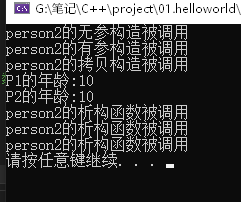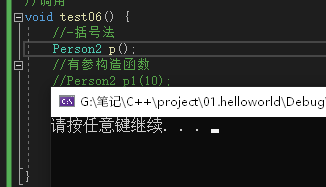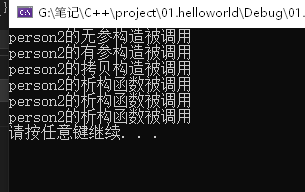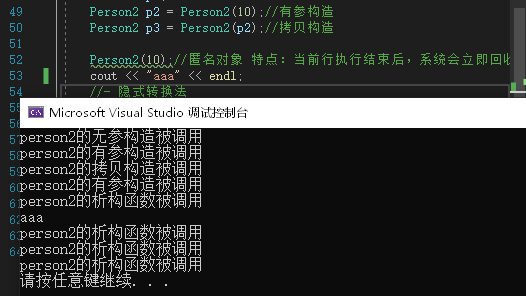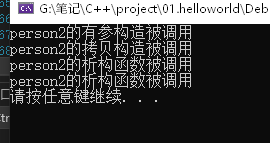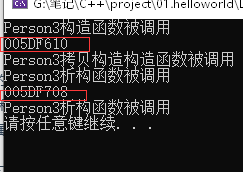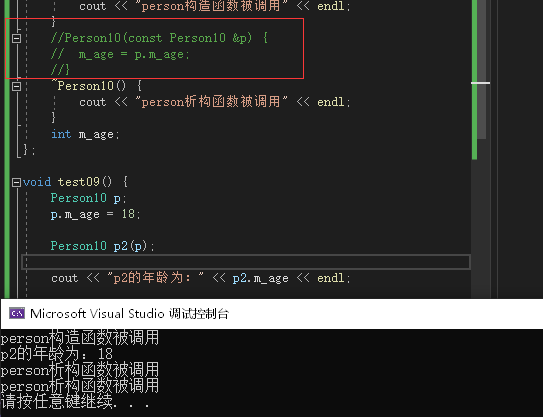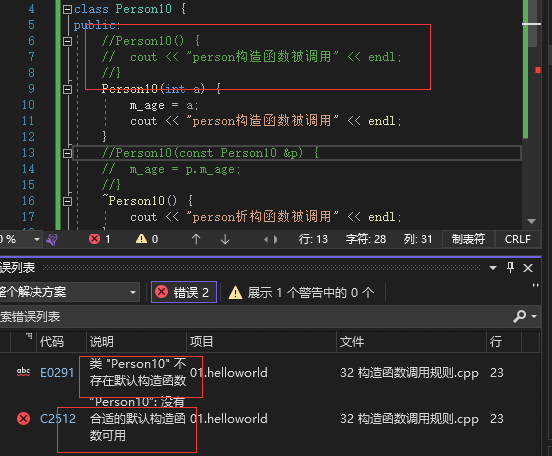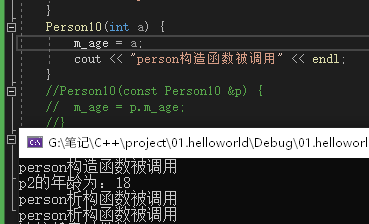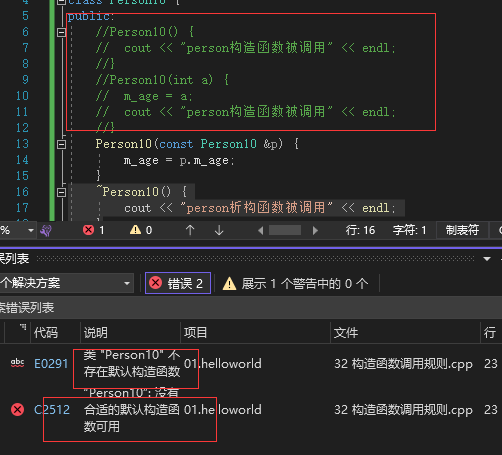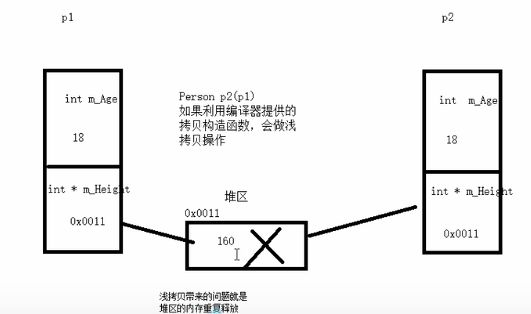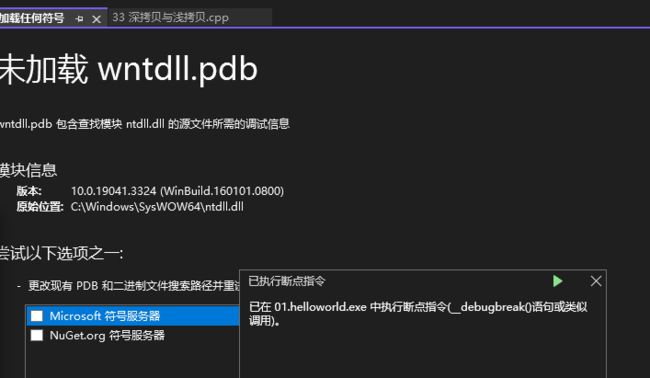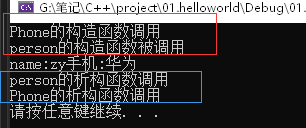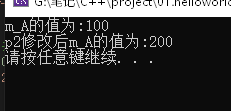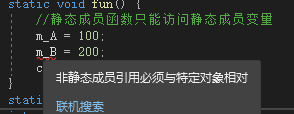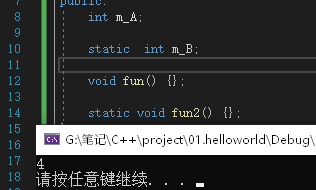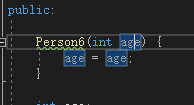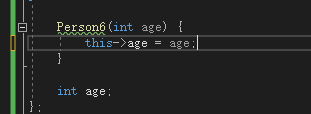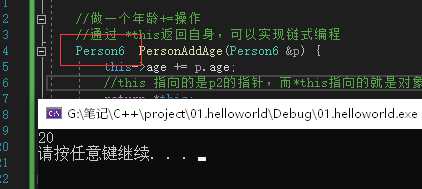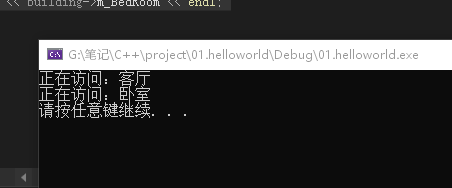C++核心编程--对象篇
4.2、对象
4.2.1、对象的初始化和清理
用于对对象进行初始化设置,以及对象销毁前的清理数据的设置。
-
构造函数和析构函数- 防止对象初始化和清理也是非常重要的安全问题
- 一个对象或变量没有初始化状态,对其使用后果是未知的
- 同样使用完一个对象或变量,没有及时清理,也会造成一定的安全问题
- 在c++中会自动被编译器调用这俩个函数,完成对象的初始化和清理工作,
因此如果我们不手动提供构造和析构,编译器提供构造函数和析构函数是空实现
- 防止对象初始化和清理也是非常重要的安全问题
-
构造函数- 主要作用在创建对象时为对象的成员属性赋值,构造函数由编译器自动调用,无需手动调用
- 写法:
类名(){}
- 构造函数,没有返回值也不写void
- 函数名称和类名相同
- 构造函数可以有参数,因此可以发生重载
- 程序在调用对象时候会自动调用构造,无需手动调用,而且只会调用一次
-
析构函数- 主要作用在对象
销毁前系统自动调用,执行一些清理 - 写法:
~类名(){}
- 析构函数,没有返回值也不写void
- 函数名称与类名相同,在名称前加上符号
- 析构函数不可以有参数,因此不可以发生重载
- 程序在对象前会自动调用析构,无需手动调用,而且只会调用一次
- 主要作用在对象
- 构造函数
#include
using namespace std;
//-构造函数,没有返回值也不写void
//- 函数名称和类名相同
//- 构造函数可以有参数,因此可以发生重载
//- 程序在调用对象时候会自动调用构造,无需手动调用,而且只会调用一次
class Person2 {
public:
Person2() {
cout << "person2的构造被调用" << endl;
}
~Person2() {
cout << "person2的析构函数被调用" << endl;
}
};
void test05() {
Person2 p1;
}
int main() {
test05();//栈上的数据执行完后会自动释放
system("pause");
return 0;
}
4.2.2、构造函数的分类和调用
- 分类方式
- 按参数分为:有参构造和无参构造
- 按类型分为:普通构造和拷贝构造
- 调用方式
- 括号法
- 显示法
- 隐式转换法
- 有参构造和无参构造
class Person2 {
public:
//无参有参构造
Person2() {
cout << "person2的构造被调用" << endl;
}
Person2(int a) {
cout << "person2的构造被调用" << endl;
}
};
- 普通构造和拷贝构造
//拷贝构造函数
Person2(const Person2 &p) {
//将传入的对象所有属性拷贝到身上
age = p.age;
}
- 括号法
//调用
void test06() {
//-括号法
Person2 p;
//有参构造函数
Person2 p1(10);
Person2 p2(p1);
cout << "P1的年龄:" << p1.age << endl;
cout << "P2的年龄:" << p2.age << endl;
//- 显示法
//- 隐式转换法
}
调用默认构造函数的时候,不要加()
加括号会让编译器认为是一个函数的声明
- 显示法
//- 显示法
Person2 p1;
Person2 p2 = Person2(10);//有参构造
Person2 p3 = Person2(p2);//拷贝构造
匿名对象:直接调用不接收。
特点:当前行执行结束后,系统会立即回收
-
注意
不要利用拷贝构造函数 初始化匿名对象
//编译器会认为 Person(p3) === Person p3; 对象声明
Person2(p3);
-
隐式转换法
//- 隐式转换法 //相当于 写了 Person2 p4 = Person(10); Person2 p4 = 10; Person2 p5 = p4; //拷贝构造
4.2.3、拷贝构造函数调用时机
c++中拷贝构造函数通常有三种情况
- 使用一个已经创建完毕的对象来初始化一个新对象
- 值传递的方式给函数参数传值
- 以值方式返回局部对象
- 使用一个已经创建完毕的对象来初始化一个新对象
#include
using namespace std;
class Person3 {
public:
Person3() {
cout << "Person3构造函数被调用" << endl;
}
Person3(int a) {
m_Age1 = a;
cout << "Person3有参构造函数被调用" << endl;
}
Person3(const Person3 & p) {
m_Age1 = p.m_Age1;
cout << "Person3拷贝构造构造函数被调用" << endl;
}
~Person3() {
cout << "Person3析构函数被调用" << endl;
}
int m_Age1;
};
//-使用一个已经创建完毕的对象来初始化一个新对象
void test06() {
Person3 p1(20);
Person3 p2(p1);
cout << "P2的年龄:"< - 值传递的方式给函数参数传值
//- 值传递的方式给函数参数传值
//值传递会拷贝一个副本
void doWork(Person3 p) {
}
void test07() {
Person3 p;
doWork(p);
}
//- 以值方式返回局部对象
int main() {
test07();
system("pause");
return 0;
}
- 以值方式返回局部对象
//- 以值方式返回局部对象
Person3 doWork2() {
//这里返回出去的是一个新的对象,会自己拷贝一个
Person3 p1;
cout << (int*)&p1 << endl;
return p1;
}
void test08() {
//这里可以测试一下是不是同一个对象
Person3 p = doWork2();
cout << (int*)&p << endl;
}
int main() {
test08();
system("pause");
return 0;
}
4.2.4、构造函数调用规则
默认情况下,c++编译器至少给一个类添加3个函数
- 默认构造函数(无参,函数体为空)
- 默认析构函数(无参,函数体为空)
- 默认拷贝构造函数,对属性进行值拷贝
构造函数调用规则如下:
- 如果用户定义有参构造函数,c++不在提供默认无参构造,但是会提供默认拷贝构造
- 如果用户定义拷贝构造函数,c++不会再提供其他构造函数
- c++编译器至少给一个类添加3个函数
#include
using namespace std;
//构造函数调用规则
class Person10 {
public:
Person10() {
cout << "person构造函数被调用" << endl;
}
Person10(int a) {
m_age = a;
cout << "person构造函数被调用" << endl;
}
Person10(const Person10 &p) {
m_age = p.m_age;
}
~Person10() {
cout << "person析构函数被调用" << endl;
}
int m_age;
};
void test09() {
Person10 p;
p.m_age = 18;
Person10 p2(p);
cout << "p2的年龄为:" << p2.m_age << endl;
}
int main() {
test09();
system("pause");
return 0;
}
正常情况下输出结构
当我们随意注释掉一个函数,编译器依然可以自动运行,给我们提供一个临时的拷贝构造函数
- 如果用户定义有参构造函数,c++不在提供默认无参构造
这里我们注释掉自己写的无参构造,运行一下。
但是会提供默认拷贝构造
- 如果用户定义拷贝构造函数,c++不会再提供其他构造函数
我们将拷贝构造以外的所有函数注释掉
4.2.5、 深拷贝与浅拷贝
浅拷贝:简单的赋值拷贝操作深拷贝:在堆区重新申请空间,进行拷贝操作
浅拷贝带来的问题就是堆区内存重复释放
如果我们在函数中开辟了一段堆区数据,我们又用的浅拷贝方式,在运行析构函数时,两块空间都指向同一个地址释放,由于先进后出的原则,前面的释放掉该地址,后面的再释放就会报错,所以需要用到深拷贝来解决该问题。
#include
using namespace std;
class Person5 {
public:
Person5() {
cout << "Person5的构造函数被调用" << endl;
}
Person5(int a,int height) {
m_age = a;
//在堆区开辟个空间
m_height = new int(height);
cout << "Person5的参数构造函数被调用" << endl;
}
//析构函数的作用就是如果在函数中在堆区开辟了空间,需要手动释放
~Person5() {
if (m_height!=NULL)
{
//释放掉空间
delete m_height;
//把值等于Null 防止野指针出现
m_height = NULL;
}
cout << "Person5的析构函数被调用" << endl;
}
int m_age;
int *m_height;
};
void test06() {
Person5 p1(18,160);
cout << "P1的年龄为:" << p1.m_age <<"身高为:" <<*p1.m_height<< endl;
Person5 p2(p1);
cout << "P1的年龄为:" << p2.m_age << "身高为:" <<*p2.m_height << endl;
}
int main() {
test06();
system("pause");
return 0;
}
这里可以看到编译器因为重复释放问题报错,为了解决这个重复释放的问题,我们自己写一个拷贝构造函数,解决浅拷贝带来的问题
//自己实现拷贝构造函数 解决浅拷贝带来的问题
Person5(const Person5 &p) {
cout << "Person拷贝构造函数调用" << endl;
m_age = p.m_age;
//深拷贝操作
m_height = new int(*p.m_height);
}
这里重新开辟空间,大小为p.m_height的解引用
总结:如果属性有在堆区开辟的,一定要自己提供拷贝构造函数,防止浅拷贝带来的问题
4.2.6、初始化列表
作用:
C++提供了初始化列表语法,用来初始化属性
语法:构造函数():属性1(值1),属性2(值2)…{}
#include
using namespace std;
class Person7 {
public:
//传统赋值操作
Person7(int a, int b, int c) {
m_a = a;
m_b = b;
m_c = c;
}
//初始化列表初始化属性
Person7(int a,int b,int c):m_a(a),m_b(b), m_c(c) {
}
int m_a;
int m_b;
int m_c;
};
void test07() {
Person7 p1(10,20,30);
cout << "p1的a值为:"<< p1.m_a << endl;
cout << "p1的b值为:"<< p1.m_b << endl;
cout << "p1的c值为:"<< p1.m_c << endl;
}
int main() {
test07();
system("pause");
return 0;
}
4.2.7、类对象作为类成员
c++类中的成员可以是另一个类的对象,我们称为该成员为
成员对象
class A{}
class B{
A a;
}
那么在创建B对象时,A,B的构造和解析的顺序是谁先谁后
#include
#include
using namespace std;
class Phone {
public:
Phone(string n):mP_Name(n) {
cout << "Phone的构造函数调用" << endl;
}
string mP_Name;
};
class Person0 {
public:
Person0(string name, string pName) :m_Name(name), m_Phone(pName) {
cout << "person的构造函数被调用" << endl;
}
string m_Name;
Phone m_Phone;
};
void test08() {
Person0 p("zy", "华为");
cout << "name:" << p.m_Name << "手机:" << p.m_Phone.mP_Name<< endl;
}
int main() {
test08();
system("pause");
return 0;
}
构造时:我们可以看到是先有成员对象,再有的自身
析构时:先自身,再成员对象
也就是像栈的先进后出,后进先出
4.2.8、静态成员
静态成员就是在成员变量和成员函数前加上关键字
static,称为静态成员
静态成员分为:
- 静态成员变量
- 所有对象共享同一份数据
- 再编译阶段分配内存
- 类内声明,类外初始化
- 静态成员函数
- 所有对象共享同一个函数
- 静态成员函数只能访问静态成员变量
- 静态成员变量
#include
using namespace std;
//静态成员变量
class Person {
public:
static int m_A;
};
//- 所有对象共享同一份数据
//- 再编译阶段分配内存
//- 类内声明,类外初始化!!!必须要类外初始化
int Person::m_A = 100;
void test05() {
Person p1;
cout << "m_A的值为:" << p1.m_A << endl;
Person p2;
//所有对象共享同一份数据
p2.m_A = 200;
cout << "p2修改后m_A的值为:" << p1.m_A << endl;
}
int main() {
test05();
system("pause");
return 0;
}
静态成员变量 不属于某个对象上,所有对象都共享同一份数据。可通过对象进行访问,也可以直接通过类名进行访问
cout << "p2修改后m_A的值为:" << p1.m_A << endl;
cout << "p2修改后m_A的值为:" << Person::m_A << endl;
如果写到private权限下那么m_A的值在类外也不可以被访问
- 静态成员函数
静态函数和静态变量使用方法类似
#include
using namespace std;
class Person2 {
public:
static void fun() {
//静态成员函数只能访问静态成员变量
m_A = 100;
//m_B = 200;
cout << m_A << endl;
}
static int m_A;
int m_B;
};
int Person2::m_A = 0;
void test06() {
Person2 p1;
//两种访问方式
p1.fun();
Person2::fun();
Person2 p2;
//共用同一个方法
p2.fun();
}
int main() {
//test05();
test06();
system("pause");
return 0;
}
静态成员函数只能访问静态成员变量
4.3、C++对象模型和this指针
4.3.1、成员变量和成员函数分开存储
在C++中,成员变量和成员函数分开存储
只有非静态成员变量才属于类的对象上
- 在C++中一个空对象占用的内存空间为1字节
#include
using namespace std;
//成员变量和成员函数分开存储
class Person {
};
void test04() {
Person p1;
//C++会给每一个空对象分配一字节空间,
//是为了区分空对象占用内存的位置
cout << sizeof(p1) << endl;
}
int main() {
test04();
system("pause");
return 0;
}
- 如果里面声明了一个非静态变量,内存空间会发生改变
class Person {
public:
int m_A;
};
void test05() {
Person p2;
cout << sizeof(p2) << endl;
}
- 静态成员变量、静态成员函数、非静态成员函数均不属于类对象上
class Person {
public:
int m_A;
static int m_B;
void fun() {};
static void fun2() {};
};
int Person::m_B = 0;
void test05() {
Person p2;
cout << sizeof(p2) << endl;
}
4.3.2、this指针概念
通过4.3.1我们知道c++中成员变量和成员函数是分开存储的
每个非静态成员函数只会诞生一份函数实例,也就是多个同类型的对象会共用一块代码,那么这块代码是如何区分是那个对象调用了自己呢?
C++通过提供特殊的对象指针this指针,解决上述问题。this指针指向被调用的成员函数所属的对象
this指针是隐含每一个非静态成员函数内的一种指针
this指针不需要定义,直接使用即可
this指针的用途:
- 当形参和成员变量同名时,可用this指针来区分
- 在类的非静态成员函数中返回对象本身,可使用return *this
this指针指向被调用的成员函数所属的对象
#include
using namespace std;
class Person6 {
public:
Person6(int age) {
age = age;
}
int age;
};
void test06() {
Person6 p1(10);
cout << "P1的值为:" << p1.age << endl;
}
int main() {
test06();
system("pause");
return 0;
}
这里会出现编译器不认识age属于同一个
所以有两种方法,第一种改变名字,第二种用this指向
- 链式编程 *this返回自身
class Person6 {
public:
Person6(int age) {
this->age = age;
}
//做一个年龄+=操作
//通过 *this返回自身,可以实现链式编程
Person6& PersonAddAge(Person6 &p) {
this->age += p.age;
//this 指向的是p2的指针,而*this指向的就是对象本体
return *this;
}
int age;
};
void test07() {
Person6 p1(10);
Person6 p2(10);
p2.PersonAddAge(p1).PersonAddAge(p1).PersonAddAge(p1);
cout << p2.age << endl;
}
如果不用解引用方式区返回,输出结果就为20
因为编译器会调用拷贝构造函数,创建一个新的对像,不会追加到自身上。
4.3.3、空指针访问成员函数
C++中空指针也是可以调用成员函数的,但是也要注意有没有用到this指针
如果用到this指针,需要加以判断保证代码的健壮性
#include
using namespace std;
class Person6 {
public:
void showClassName() {
cout << "this is Person class" << endl;
}
void showPersonAge() {
//报错原因是因为传入的指针为Null
if (this == NULL)
{
return;
}
cout << "age=" < m_Age << endl;
}
int m_Age;
};
void test05() {
Person6 *p = NULL;
p->showClassName();
p->showPersonAge();
}
int main() {
system("pause");
return 0;
}
4.3.4、const修饰成员函数
常函数:
- 成员函数后加const后我们称为这个函数为
常函数 - 常函数内不可以修改成员成员属性
- 成员属性声明时加关键字mutable后,在常函数中依然可以修改
常对象:
- 声明对象前加const称该对象为常对象
- 常对象只能调用常函数
class Person {
public:
//this指针的本质 是指针常量 指针的指向是不可以修改的
// const Person * const this;
//在成员函数后面加const,修饰的是this指向,让指针指向的值也不可以修改
void showPerson() const {
this->m_B = 100;
//this = NULL;
}
void func() {
m_A = 100;
}
int m_A;
//特殊变量,即使在常函数中,也可以修改该值,加关键字mutable
mutable int m_B;
};
void test05() {
Person p1;
p1.showPerson();
}
void test06() {
const Person p; //在对象前加const,变为常对象
//p.m_A = 100;
p.m_B = 100;//m_B是特殊值,在常对象也可以修改
//常对象只能调用常函数
p.showPerson();
//p.func(); //常对象不可以调用普通成员函数,因为普通成员函数可以修改属性
}
4.4、友元
在程序里,有些私有属性也想让类外特殊的一些函数或者类进行访问,就需要用到友元的技术
友元的目的就是让一个函数或者类,访问另一个类中私有成员
关键字:friend
- 三种实现
- 全局函数做友元
- 类做友元
- 成员函数做友元
- 全局函数做友元
#include
using namespace std;
class Building {
//为了让全局函数访问到私有的权限可以利用friend关键字
friend void goodGay(Building* building);
public:
Building() {
m_sittingRoom = "客厅";
m_BedRoom = "卧室";
}
public:
string m_sittingRoom;
private:
string m_BedRoom;
};
//全局函数
void goodGay(Building *building) {
cout << "正在访问:" << building->m_sittingRoom << endl;
cout << "正在访问:" << building->m_BedRoom << endl;
}
void test05() {
Building buiding;
goodGay(&buiding);
}
int main() {
test05();
system("pause");
return 0;
}
- 类做友元
#include
#include
using namespace std;
class Building {
//为了让类访问到私有的权限可以利用friend关键字
friend class GoodGay;
public:
Building();
public:
string m_sittingRoom;
private:
string m_BedRoom;
};
class Building;
class GoodGay {
public:
GoodGay();
//访问Building中的属性
void visit();
Building * building;
};
//类外写成员函数
Building::Building() {
m_sittingRoom = "客厅";
m_BedRoom = "卧室";
};
GoodGay::GoodGay() {
//指向
building = new Building;
}
void GoodGay::visit() {
cout << "类正在访问:" << building->m_sittingRoom << endl;
cout << "类正在访问:" << building->m_BedRoom << endl;
};
void test05() {
GoodGay gg;
gg.visit();
}
int main() {
test05();
system("pause");
return 0;
}
- 成员函数做友元
#include
#include
using namespace std;
class Building;
class GoodGay {
public:
GoodGay();
//让visit函数可以访问Building中的私有成员
void visit();
//让visit2函数不可以访问Building中的私有成员
void visit2();
private:
Building *building;
};
class Building {
friend void GoodGay::visit();
public:
Building();
public:
string m_sittingRoom;
private:
string m_BedRoom;
};
Building::Building() {
m_sittingRoom = "客厅";
m_BedRoom = "卧室";
}
GoodGay::GoodGay() {
building = new Building;
}
void GoodGay::visit() {
cout << "函数正在访问:" << building->m_sittingRoom << endl;
cout << "函数正在访问:" << building->m_BedRoom << endl;
};
void GoodGay::visit2() {
cout << "函数正在访问:" << building->m_sittingRoom << endl;
};
void test07() {
GoodGay gg;
gg.visit();
}
int main() {
test07();
system("pause");
return 0;
}
4.5、运算符重载
概念:对已有的运算符重新进行定义,赋予其另一种功能,以适应不同的类型数据
对于内置的数据类型的表达式的运算符是不能被修改的
例:1+1=0 是不被允许的
不能滥用运算符重载
例:原本为加法 写成 乘法
- 关键字:operator
4.5.1、加号运算符重载
- operator+
#include
using namespace std;
//加号运算符重载
class Person {
public:
//成员函数重载+号
//Person operator+(Person& p1) {
// Person temp;
// temp.m_valueA = p1.m_valueA + this->m_valueA;
// temp.m_valueB = p1.m_valueB + this->m_valueB;
// return temp;
//}
public:
int m_valueA;
int m_valueB;
};
//全局实现
Person operator+(Person &p1, Person& p2) {
Person temp;
temp.m_valueA = p1.m_valueA + p2.m_valueA;
temp.m_valueB = p1.m_valueB + p2.m_valueB;
return temp;
}
//重载实现
Person operator+(Person &p1, int num) {
Person temp;
temp.m_valueA = p1.m_valueA + num;
temp.m_valueB = p1.m_valueB + num;
return temp;
}
int main() {
Person p1,p2,p3;
p1.m_valueA = 10;
p1.m_valueB = 20;
p2.m_valueA = 10;
p2.m_valueB = 20;
p3 = p1 + p2;
cout << p3.m_valueA << '\n' << p3.m_valueB << endl;
//重载
p4 = p1 +10;
cout << p4.m_valueA << '\n' << p4.m_valueB << endl;
system("pause");
return 0;
}
4.5.2、左移运算符重载
- 关键字operator<<
#include
using namespace std;
class Person {
friend ostream& operator<<(ostream& cout, Person& p);
public:
Person(int a, int b) {
m_A = a;
m_B = b;
}
private:
int m_A;
int m_B;
};
//ostream 输出流类型
ostream& operator<<(ostream &cout,Person &p) {
cout << "A:" << p.m_A << " B:" << p.m_B;
return cout;
}
void test07() {
Person p1(10,10);
cout << p1 << endl;;
}
int main() {
test07();
system("pause");
return 0;
}
4.5.3、后置运算符重载
- operator++() 前置
- operator++(int) 后置
前置递增返回引用,后置递增返回值
#include
using namespace std;
//重载递增
class MyInterger {
friend ostream& operator<<(ostream& cout, MyInterger myint);
public:
MyInterger() {
m_Num = 0;
}
//重载前置++运算符
MyInterger& operator++() {
m_Num++;
return *this;
}
//重载后置++运算符
//int 代表占位可以用于区别前置和后置
MyInterger operator++(int) {
//先记录当时结果
MyInterger temp = *this;
//后递增
m_Num++;
//最后将记录的结果做返回
return temp;
}
private:
int m_Num;
};
//重载<<运算符
ostream& operator<<(ostream& cout, MyInterger myint) {
cout << myint.m_Num << endl;
return cout;
}
void test06() {
MyInterger myint;
cout << ++myint << endl;
}
int main() {
test06();
system("pause");
return 0;
}
4.5.4、赋值运算符重载
- operator=
#include
using namespace std;
//赋值运算符重载
class Person {
public:
Person(int age) {
m_Age = new int(age);
}
~Person()
{
if (m_Age !=NULL)
{
delete m_Age;
m_Age = NULL;
}
}
//重载 赋值运算符
Person operator=(Person& p) {
//先判断是否有属性在堆区如果有先释放干净,然后再深拷贝
if (m_Age != NULL)
{
delete m_Age;
m_Age = NULL;
}
//深拷贝
m_Age = new int(*p.m_Age);
//返回本身
return *this;
}
int* m_Age;
};
void test01() {
Person p1(18);
Person p2(20);
Person p3(40);
p3 = p2 = p1;
cout << *p1.m_Age << endl;
cout << *p2.m_Age << endl;
}
int main() {
test01();
system("pause");
return 0;
}
4.5.5、关系运算符重载
- operator==
- operator!=
#include
#include
using namespace std;
class Person {
public:
Person(string name, int age){
m_Name = name;
m_Age = age;
}
//重载等号
bool operator==(Person &p) {
if (this->m_Name == p.m_Name && this->m_Age == p.m_Age)
{
return true;
}
return false;
}
//重载不等号
bool operator!=(Person &p) {
if (this->m_Name != p.m_Name && this->m_Age != p.m_Age)
{
return false;
}
return true;
}
public:
string m_Name;
int m_Age;
};
void test01() {
Person p1("Tom", 18);
Person p2("Tom", 18);
Person p3("jeery", 18);
if (p1==p2)
{
cout << "P1和P2相等" << endl;
}
else {
cout << "P1和P2不相等" << endl;
}
if (p1!=p3)
{
cout << "P1和P3不相等" << endl;
}
else {
cout << "P1和P3相等" << endl;
}
}
int main() {
test01();
system("pause");
return 0;
}
4.5.6、函数调用运算符重载
- 函数调用运算符()也可以重载
- 由于重载后使用的方式非常像函数的调用,因此称为仿函数
- 仿函数没有固定写法,非常灵活
- operator()
//匿名函数对象
MyAdd()(100, 100)
#include
#include
using namespace std;
class MyPrint {
public:
//重载函数调用运算符
void operator()(string test) {
cout << test << endl;
}
};
void test01() {
MyPrint myPrint;
myPrint("hello world");//由于使用起来非常类似于函数调用,因此称为仿函数
}
//仿函数非常灵活,没有固定的写法
//加法类
class MyAdd {
public:
int operator()(int num1, int num2) {
return num1 + num2;
}
};
void test02() {
MyAdd m1;
int sum = m1(100, 100);
cout << sum << endl;
//匿名函数对象
cout << MyAdd()(100, 100) << endl;
}
int main() {
//test01();
test02();
system("pause");
return 0;
}

